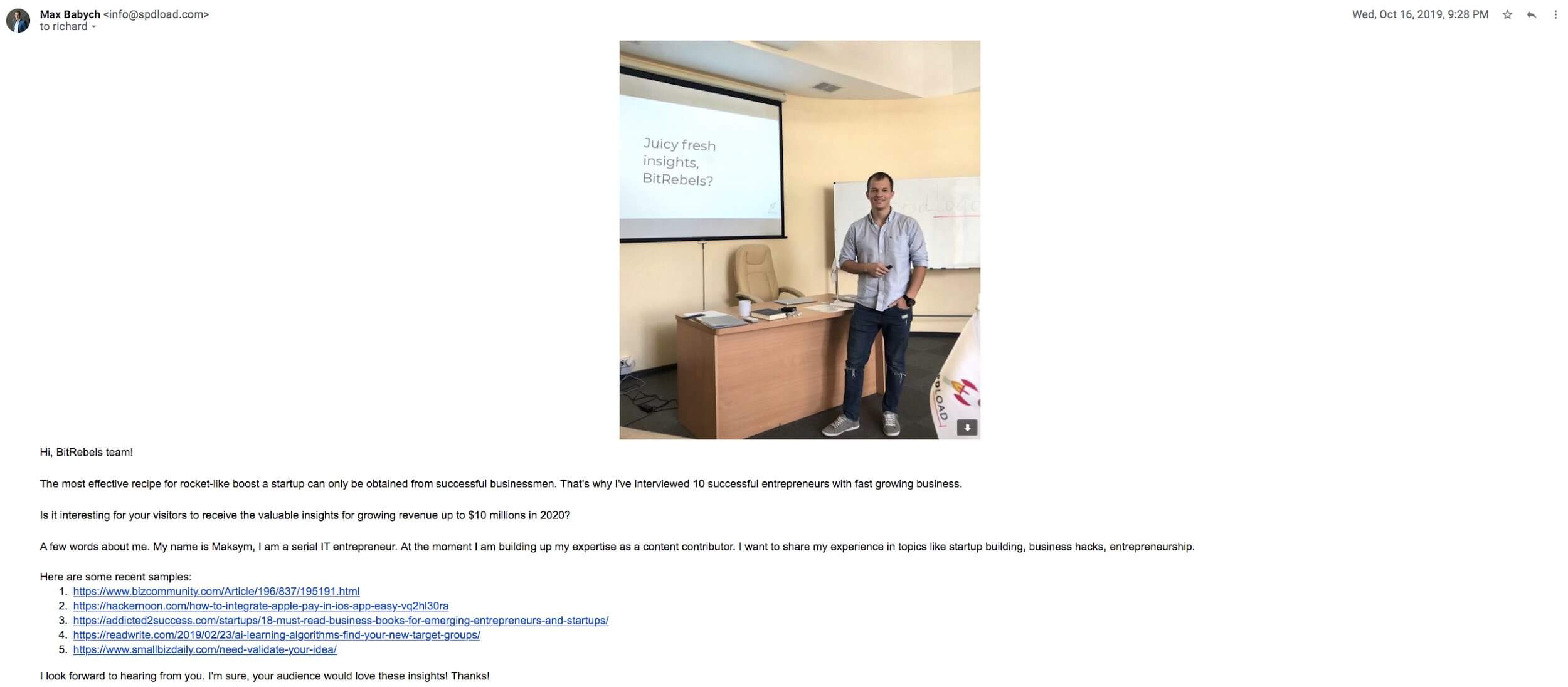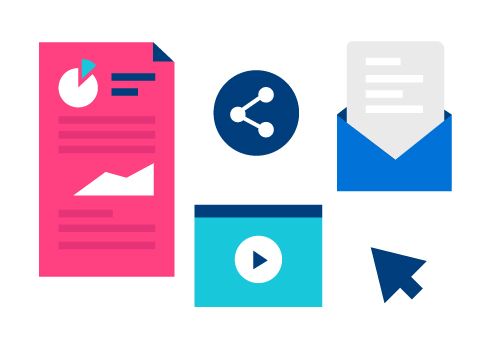Outreach Marketing: Outreach Strategies That Convert

Contents
Whether your objective is closing a sales deal or securing a valuable backlink, a highly effective outreach strategy is essential.
Why? With 306.4 billion emails people send and receive each day, it can be daunting to cut through the noise and get your email opened, read, and replied.
If you send a cold email, it can be even harder.
To help you navigate this landscape, we’ve engaged with 21 experts who generously shared their preferred outreach strategies. In this article, we present seven of the best email outreach tactics, complemented by expert insights and real-life examples to ignite inspiration for your upcoming outreach campaigns.”
#1. Do Research
Any outreach campaign must include research. To grow through email outreach and tailor your efforts to your recipient’s current expectations, you need to do research. Not only does it help to improve your open rate, but it also allows you to understand your recipient better and therefore stay ahead of your competitors who also hope for the attention of the same person.
Nico Prins, founder of Launch Space, finds it useful to leverage LinkedIn first as it helps to establish a connection with the person before asking for something.
“I find LinkedIn to be one of the most effective outreach channels for high DR/ DA sites. You can easily find and connect with relevant editors. Moreover, because people get less pitches on LinkedIn, you are more likely to get an answer to your query.”

Lidia Bondarenko, outreach manager at HelpCrunch, also encourages people to use LinkedIn. However, she also recommends to analyze competitors:
“One of our most successful sales email outreach campaigns has been around targeting our competitors’ users. For example, we’ve targeted customers of Intercom – our biggest competitor in the customer communication software space. We’ve first reached out to Intercom users via sending LinkedIn invites, and in case of no signs of reaction, a 5-step email sequence was set to launch after a week.”
And Kasia Majewska, marketing executive at NapoleonCat, agrees that doing research on social media gives results:
“My rule number one is being polite, always. Another thing that I do is mentioning a point of reference: I usually tell the person I’m reaching out to that I saw their publications somewhere else, for example on a Facebook or LinkedIn group. This method puts your outreach in a context and it basically equips you with a reason to reach out.”
But if you don’t have time or desire to establish a connection before sending your outreach email, you still have to do research. For example, Tytus Golas, founder of Tidio Live Chat, suggests looking for relevant listicle posts. When you reach out to a person with a direct question, you’re more likely to get a positive reply:
“One of the outreach strategies that turned out to be super successful for our link-building efforts was trying to get Tidio included on various “tools’ lists” where our product was a good fit. We’ve researched listicle posts related to sales, lead generation and customer service tools and then reached out to those blogs and asked for an inclusion. Of course, we didn’t want to go empty-handed so we offered to either promote a post after we were featured or suggested other kinds of compensation, depending on what the other party was expecting. We’ve seen awesome results and managed to build quite a lot of links in this way.”

#2. Hook Recipients from the First Sentences
Modern users receive a great number of emails daily, so it’s important to stand out from the crowd and get your email opened and read. With an average attention span of 8 seconds, you don’t have much time to hook the attention of your recipient.
The subject line is your visit card that can pique the recipient’s curiosity and encourage him or her to open your email and read it. According to one research, 47% of email recipients open email based on the subject line and 69% report email as spam based only on the subject line.
Georgios Chasiotis, managing director at MINUTTIA, pays close attention to the subject lines and tests various formulas to get better results.
“Last April, we’ve started testing something new when it comes to the subject lines of our cold emails. Even though we’ve started testing this new approach for our own agency needs, we then expanded it on our clients, based on the results that we were getting.
The logic behind this tactic is simple, but powerful. You reach out to prospects who have recently achieved something noteworthy. In a nutshell, your subject line will be: Congrats on {something noteworthy}. Through a process of trial and error, we’ve found out that this tactic can be a great conversation starter. Just try to focus on building relationships rather than just to sell.”
Chasiotics provides the following examples of this approach:
– Congrats on raising your Seed round
– Congrats on launching your new website
– Congrats on launching your landing pages feature
Henry Cazalet, director of The SMS Works LTD, also believes that the subject line matters, so it’s a good idea to hook your recipient with it: “The best tip is to use controversy in the subject line. Taking a controversial position or challenging accepted beliefs is a powerful way of grabbing attention.”
If your email is opened, that’s great. But if you want to get results with your email outreach campaign, you need to encourage the recipient to read it. Thus, your email intro also matters. Here’s what Arek Ponski, CEO of TeamBuzz, recommends:
“Over the last few months I’ve experimented a lot with cold emails outreach. As a founder of a new business, I had to find the best way to reach out to my target audience and convince them to try my solution. Eventually I crafted a version of a pitch (cold email) that landed me leads and sparked interest among my target audience. It starts with a simple, but interesting subject line and goes on to provide useful, relevant (and surprising) information to the recipient.”
Now take a look at an example of an outreach email Ponski sends to his contacts:

#3. Add Personalization
Sending your email, you want to avoid spam filters, right? Not only should you delete all spam trigger words, false promises, and exclamation points, but you also need to avoid sending the same emails to various recipients.
People crave authenticity, so adding personalization to your email outreach is a must, and experts agree. Here’s what Kas Szatyłowicz, content manager at Digital Olympus, says:
“All my emails are highly personalized. Apart from mentioning the blogs I’ve written for before, I always try to refer to someone we (I and the editor) know in common. This is great for boosting trust and building a relationship. To save time for both sides, I also suggest 3-5 topics I could write about with a note saying that I’m also open to the editor’s suggestion. So far, I get around 85% of the writing gigs that I apply for.”
Alicja Olko, outreach specialist at CandyBar, also claims that using customize templates is a great idea when it comes to email outreach:
“I like to keep it as personal and as customizable at the same time as possible. With all the softwares available, it’s pretty easy to create a template and bulk-send it. But it’s also pretty obvious for the recipient that he has been part of an automatic outreach campaign. For me the key to success is balance: use a template that is easy to customize and adjust, do your research and find direct contact details to keep personal, check the lead’s website to make sure you know what sort of content appears there and show that you did your homework in the email. All these steps take little time, but bring big results. My response rate is usually around 15%.”
Here’s a template Alicja Olko uses:

Nikola Baldikov, digital marketing manager at Brosix, claims that providing social proof is a great idea to add personalization and increase trust. Just take a look at his example below:

Not only does Baldikov add his writing samples, but he also includes his social media handles to make it easier for the recipient to learn more about Nikola.
Since 65% of people are visual learners, you can also use images to personalize your emails, and Maksym Babych, CEO of SpdLoad, believes in the power of this tactic:
“ It may be some targeted actions, for example, I’m standing with a laptop on which the site of the person to whom I am writing is open. In fact, I took a photo with a laptop and a screen off or you can stand near the projector as if you have a presentation for the client.”
Here’s how it looks like in action:

If you want to create a similar image, you can use an online graphic design tool to add text on your photo with ease.
#4. Provide Value First
Whether you like it or not, people are self-focused which means we put our needs first. However, providing value first gives a great opportunity to use the power of psychology and establish a connection with recipients. When it comes to email outreach, the norm of reciprocity still works. In other words, people feel obligated to return the favor when someone does something for us.
It’s psychologically proven that people like being appreciated. When you reach out to experts and prove their niche expertise, they are more likely to reply to your email. Moreover, you can In other words, it helps to establish a connection and get wonderful results with time. Vlad Turchyn, off site SEO manager at Preply, believes in this tactic:
“One of the most effective ways of scratching the back of your prospects first is by inviting them to participate in a roundup post with other experts. Along with their commentaries, you must include a backlink to their site as a way of giving thanks for their effort.”
If you’re looking for guest posting sites, learn from Adam Enfroy, founder & blogger at AdamEnfroy.com, who also tries to provide value first. Let’s take a look at his outreach email:

Here’s what Adam says: “Successful bloggers’ inboxes are flooded with hundreds of cold emails every week. The emails that stand out are the ones that offer something of value in return. And I use these tactics in my own guest posting and link building email outreach. As you can see in my example email, I start with credibility – “250,000 monthly readers” – then offer something of value: links from other high Domain Authority (DA) blogs. Since I write 8-10 guest posts/month, I can easily add a link for other sites and this value-add increases my response rate substantially for guest posts and links.”
Olga Mykhoparkina, CMO at Better Proposals, believes that offering content promotion can also help to get a reply:
“With guest blog outreach, it’s important to mention how you’re going to help with the post promotion whether it’s sharing with your social media followers, relevant Facebook/LinkedIn groups or sending an email blast to your subscribers.”
Here’s how Olga writes about post promotion potential in the body of her email:

Hunter Branch, founder of Rank Tree, knows that free stuff is irresistable, so he offers a free bonus: “My favorite link building outreach tactic is offering a free bonus to the person you reach out to regardless of whether they add your link or not. This could be a course, membership, or eBook that has high perceived value. I’ve seen this increase my conversion rates from 2% to 15% across several different industries.”
Here are 10 different ways you can get on a prospect’s radar before going in for the hard sell. These tactics will increase your chances of getting a click-through and a response:
- Leave genuine, meaningful comments on their blog posts
- Interact with them on Twitter—retweet them, join a thread they’ve started, or tag them in a relevant conversation
- Interact with them in shared communities on Facebook, Slack and other forums
- Show your support on social media by downloading their latest ebook or contributing to the nonprofit that they champion
- Send a thoughtful email—personalize it by referencing something you saw on their social profile
- Recommend them to others
- Send them a resource that they will find valuable
- Acknowledge their wins on social media and try to start a genuine conversation
- Get on a virtual chat with them
- Engage with them on LinkedIn
It doesn’t take long to send an outreach email, but by doing some homework and going the extra mile you can definitely increase your chances of getting a positive response and building a long-lasting relationship.
#5. Use Humor in Your Message
Serious outreach emails are boring. They don’t cause emotions and they often go to the bin. However, positive emotions deepen your relationship bond, so it’s a great idea to use humor in your message.
Moreover, funny emails are memorable and eye-catching. From witty wordplay to funny memes and jokes, there are many ways to add humor to your pitch. For example, Kas Andz, founder of Kas Andz Marketing Group, loves using cat memes: “Using attention grabbing subject lines, using humour or being a bit different. For example that is a recent example where we were continually sending emails to a lead and not getting responses. So I just sent a silly meme of a cat. That got his attention and a reply – and turned out to be a source of a lot of potential future business.”
And Shaurya Jain, founder of Attention Always, also believes that humor is powerful: “My favorite Email Outreach Tactic is making the email humorous. Everyone tends to be very formal and uptight in their emails. To stand out, I use humor. It makes my emails more personable. Some Humor formats that anyone can use include the rule of 3 and memes.
In the rule of 3, you mention two things that are formal and expected. The third thing is funny and unexpected. For example, in your job title you can write – CEO, Writer, Wannabe Rapper.”
Check out Jain’s email example:

#6. Make it easy to reply
This is crazy: people spend 2.5 hours on email daily. Since the number of received and sent emails is constantly growing, people spend much time reading and replying to them. But if you want to hear back from your recipient, make it easy to reply.
For example, Joyce Chou, content marketing strategist at Compose.ly, offers to use a numbered list of responses:
“At Compose.ly, we’ve recently found a new favorite outreach tactic that makes it easy for recipients to respond. Last December, we emailed all of the contacts in our database that we did not have an active relationship with (as in, no active correspondence within the previous 90 days). We let them know we were cleaning our contact database and wanted to request their help. Our email included a numbered list of responses, inviting recipients to reply back with the number that corresponded to their respective circumstances. This made it incredibly easy for recipients to tell us whether they’d want to learn more about Compose.ly’s services, be removed from our mailing list, or confirm that they were already using our service. All they had to do was reply with a number.”
When asking for a backlink to MC2 Bid4Papers, I always value the recipients’ time, so I often send emails that require a simple yes or no reply from the prospect, just like in the example below:

#7. Follow Up
Having a high open rate is great but it’s not enough to get a reply. Since people have a short attention span, it doesn’t take much time or effort to get distracted. As a result, they forget about your email and never reply. In fact, 70% of sales emails don’t go past the first attempt.
When it comes to cold emails, follow ups are an important part of your outreach strategy. Nigel Lindemann, digital marketer at Survey Anyplace, claims that the right number of follow up emails matters: “The best tactic is providing the right number of follow-up emails. This can be tricky if you reach out to people across the globe. People have different habits when it comes to email etiquette. Recipients in the United States usually are more familiar with several follow-up emails, compared to Europe, where too many follow-up emails in a short period can come across as too aggressive. Ideally, we sent out one email with 2 to 3 reminders spread out over 14 days.”
Many experts agree that the optimal number is 2-3 follow-up emails. But sometimes one follow up email is enough.
For example, Maria Sereda, brand and community manager at Serpstat, believes that follow up email must be short and eye-catching and it gives results: “Waiting for a reply from the editor for several days, I’ve sent him an email with the waiting GIF and got back a reply in 5 minutes.”
Just take a look at Maria’s example:

How to Run an Outreach Campaign That Uses Content
Why Use Content In your Outreach
 Cold outreach allows you to connect with people who fit your ideal customer persona. With B2B cold outreach, you are rarely looking to make a sale directly. Rather, you are seeking a response to your message.
Cold outreach allows you to connect with people who fit your ideal customer persona. With B2B cold outreach, you are rarely looking to make a sale directly. Rather, you are seeking a response to your message.
If you can generate a response and get that person on a call, you can push them down your sales funnel.
Most agencies and freelancers I’ve encountered use cold outreach for lead generation. Often, they use one of the following resources as a hook to generate a response:
- Strong service offering: it could be a special offer, or something similar
- Consultation: get the person on a call and show your expertise
- Case study: show expertise and your ability to deliver results
Each of these approaches can be effective. I’ve read many case studies of agencies implementing one or all of these strategies to generate leads. I’ve yet to read a case study of an agency using blog content in its sales outreach.
Nico Prins agency, Launch Space & his website Free Domain Name Generator relies heavily on cold outreach to generate sales. For the last few months, he’s been experimenting with utilizing blog content as a sales asset. The results have been impressive. Securing an average of two new clients a month.
For an agency, that’s a decent number.
They’ve yet to implement a coherent sales and marketing strategy. Once they’ve secured two clients in a month, he closes the doors and hire more staff. He believes that he could probably scale our growth, but the quality of service delivery would suffer.
The average order value for a new client is over $1,000. In 80% of cases, increasing the average order value within a quarter to a minimum of $2,000 a month. A single client is, therefore, worth around $24,000 gross a year to the business. With two new clients a month, that’s averaging out at around $48,000.
What Type of Content Should You Share
 You don’t need a large amount of content on your blog to run the cold outreach strategy I’m about to share. You don’t even need to publish the content on your blog.
You don’t need a large amount of content on your blog to run the cold outreach strategy I’m about to share. You don’t even need to publish the content on your blog.
More on that later…
The content you produce and share should have the following characteristics:
- Actionable: reveal something about the service you provide
- Relevant: how the service benefits the customer, with some examples
- Awesome: create great content. The content you’ll be sharing is the first impression a potential customer will have of your business.
That benefit to the customer is vital. If the person reading your content doesn’t think it’s relevant, you’ll never generate interest.
At this point, you probably want an example of some content. Here’s a piece of content that Nico used in my outreach: How to Scale Your Guest Posting Ethically
If you check out the content, you’ll see that it is:
- Actionable: a step-by-step guide on how we run guest post campaigns at Launch Space. This is our primary service offering
- Relevant: if you’re part of a marketing team at a SaaS company, my target audience, you’ll find the content useful
- Awesome: It is a good piece of content that is easy to follow
The article should give you an idea of the type of top of the funnel content for cold outreach.
If you’re not sure what kind of content to produce, consider your customer pain points. You can conduct interviews with existing customers to see what type of problems they have that you’re solving. List your ideas and then pick the best ones.
Below are a couple of examples that I might send as an SEO agency:
- The Definitive Guide to Optimizing Site Speed – send this article to businesses with a slow website
- How to Guest Post Like a Pro & Double Your Traffic – send to companies who need help scaling their traffic
- The Definitive Guide to On-Site Optimization – send to businesses who have issues with internal linking, and website structure
You can probably see where I’m going with this.
Identify a need, and offer a relevant solution. If you can do this, you drastically improve your chance of getting a response. It’s not rocket science. It’s logic.
Create Your Email Template
You need a great email template for your outreach. Creating an engaging outreach email takes practice. Even when you know what you’re doing, you should create a couple of variations of a template and split test them because some messages will generate a higher response rate.
You won’t know which version of the copy will convert the best until you run a test. That’s where tools like Mailshake, which allow you to compare results come in handy.
Nico’s email copy always has the following characteristics:
- Short: Rarely write an email that is more than three to four paragraphs
- Direct: The tone is friendly and professional. Don’t use humor because humor is subjective. John Caples, David Ogilvy, and many other now deceased copywriters never used humor to sell. I just accept that advice
- Clear CTA: It should be obvious what action you want the person to take
- End with a Hook: Use a PS or the email signature as a final hook
Conclusion
No matter what your outreach purpose is, whether you want to secure collaboration opportunities with niche influencers, get a backlink, or close a sales deal, it’s important to have a winning outreach strategy that gives results.
Obviously, there’s no one-size-fits-all approach to email outreach, but many tips have been tested by different experts and they give results. Thus, it’s a good idea to listen to experts and give their favorite tactics a try.





